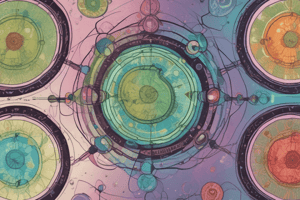Podcast
Questions and Answers
What are chromosomes made up of?
What are chromosomes made up of?
- RNA and proteins
- DNA and proteins (correct)
- Proteins only
- DNA only
What is genetic inheritance determined by?
What is genetic inheritance determined by?
- The diet of the parents
- The age of the parents
- The combination of genes inherited from each parent (correct)
- The environment
How much genetic material does each parent contribute to their offspring?
How much genetic material does each parent contribute to their offspring?
- One-third
- Two-thirds
- One-fourth
- Half (correct)
What determines the traits of the offspring?
What determines the traits of the offspring?
If one parent has the gene for brown eyes and the other has the gene for blue eyes, what is the chance of their offspring inheriting the gene for brown eyes?
If one parent has the gene for brown eyes and the other has the gene for blue eyes, what is the chance of their offspring inheriting the gene for brown eyes?
What insight does genetics provide into living organisms?
What insight does genetics provide into living organisms?
What is the molecule that carries genetic information from parents to their offspring?
What is the molecule that carries genetic information from parents to their offspring?
What are the basic units of inheritance and are responsible for the development and function of an organism?
What are the basic units of inheritance and are responsible for the development and function of an organism?
Which of the following are the four nitrogenous bases found in DNA?
Which of the following are the four nitrogenous bases found in DNA?
What is the study of heredity and the variation of inherited traits in populations?
What is the study of heredity and the variation of inherited traits in populations?
What is responsible for determining the genetic code of an organism?
What is responsible for determining the genetic code of an organism?
What are segments of DNA that contain the instructions for the production of a specific protein or RNA molecule?
What are segments of DNA that contain the instructions for the production of a specific protein or RNA molecule?
Study Notes
Biology
Biology is the scientific study of living organisms and their interactions with each other and the environment. It is a vast field that encompasses many subdisciplines, including genetics. Genetics is the study of heredity and the variation of inherited traits in populations. In this article, we will explore the basics of genetics, including DNA, genes, and genetic inheritance.
DNA
DNA (deoxyribonucleic acid) is the molecule that carries genetic information from parents to their offspring. It is made up of two long strands of nucleotides that are coiled together to form a double helix. Each nucleotide is made up of a sugar molecule, a phosphate group, and one of four nitrogenous bases: adenine (A), thymine (T), guanine (G), and cytosine (C).
The sequence of these bases in DNA determines the genetic code. The code is read and translated by the cell's machinery to produce proteins, which are responsible for many of the functions of the cell.
Genes
Genes are segments of DNA that contain the instructions for the production of a specific protein or RNA molecule. They are the basic units of inheritance and are responsible for the development and function of an organism.
Genes can vary in size and complexity, ranging from a few hundred to several million base pairs. They are organized into chromosomes, which are structures made up of DNA and proteins that are present in the nucleus of a cell.
Genetic Inheritance
Genetic inheritance is the way in which traits are passed down from parents to their offspring. It is determined by the combination of genes inherited from each parent.
Each parent contributes half of their genetic material to their offspring. This means that each offspring receives one copy of each gene from each parent. The combination of these genes determines the traits of the offspring.
For example, if two parents both have the gene for brown eyes, their offspring will also have the gene for brown eyes. However, if one parent has the gene for brown eyes and the other has the gene for blue eyes, their offspring will have a 50% chance of inheriting the gene for brown eyes and a 50% chance of inheriting the gene for blue eyes.
Conclusion
Genetics is a fascinating and complex field that is essential to our understanding of living organisms. It provides insight into the mechanisms of inheritance and the factors that contribute to the development and function of organisms. By studying genetics, we can gain a deeper understanding of the biological world and the processes that shape it
Studying That Suits You
Use AI to generate personalized quizzes and flashcards to suit your learning preferences.
Description
Test your knowledge of genetics basics, including DNA, genes, and genetic inheritance in living organisms. Explore the fundamental concepts that underpin the study of heredity and genetic variation.




